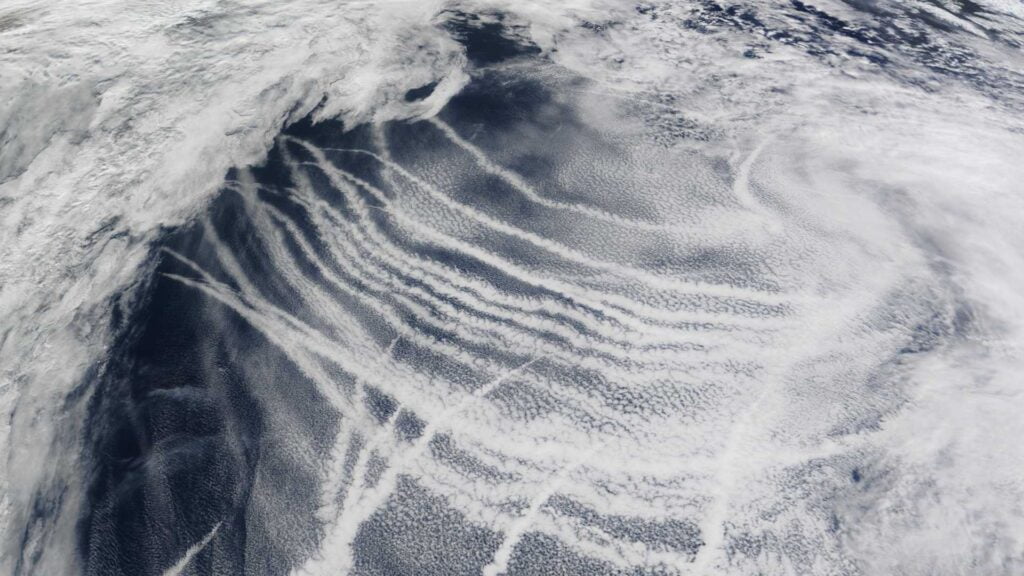As we confront the enormous challenge of climate change, we should take inspiration from even the most unlikely sources. Take, for example, the tens of thousands of fossil-fueled ships that chug across the ocean, spewing plumes of pollutants that contribute to acid rain, ozone depletion, respiratory ailments, and global warming.
The particles produced by these ship emissions can also create brighter clouds, which in turn can produce a cooling effect via processes that occur naturally in our atmosphere. What if we could achieve this cooling effect without simultaneously releasing the greenhouse gases and toxic pollutants that ships emit? That’s the question the Marine Cloud Brightening (MCB) Project intends to answer.

Scientists have known for decades that the particulate emissions from ships can have a dramatic effect on low-lying stratocumulus clouds above the ocean. In satellite images, parts of the Earth’s oceans are streaked with bright white strips of clouds that correspond to shipping lanes. These artificially brightened clouds are a result of the tiny particles produced by the ships, and they reflect more sunlight back to space than unperturbed clouds do, and much more than the dark blue ocean underneath. Since these „ship tracks“ block some of the sun’s energy from reaching Earth’s surface, they prevent some of the warming that would otherwise occur.
The formation of ship tracks is governed by the same basic principles behind all cloud formation. Clouds naturally appear when the relative humidity exceeds 100 percent, initiating condensation in the atmosphere. Individual cloud droplets form around microscopic particles called cloud condensation nuclei (CCN). Generally speaking, an increase in CCN increases the number of cloud droplets while reducing their size. Through a phenomenon known as the Twomey effect, this high concentration of droplets boosts the clouds‘ reflectivity (also called albedo). Sources of CCN include aerosols like dust, pollen, soot, and even bacteria, along with man-made pollution from factories and ships. Over remote parts of the ocean, most CCN are of natural origin and include sea salt from crashing ocean waves.

The aim of the MCB Project is to consider whether deliberately adding more sea salt CCN to low marine clouds would cool the planet. The CCN would be generated by spraying seawater from ships. We expect that the sprayed seawater would instantly dry in the air and form tiny particles of salt, which would rise to the cloud layer via convection and act as seeds for cloud droplets. These generated particles would be much smaller than the particles from crashing waves, so there would be only a small relative increase in sea salt mass in the atmosphere. The goal would be to produce clouds that are slightly brighter (by 5 to 10 percent) and possibly longer lasting than typical clouds, resulting in more sunlight being reflected back to space.
Most approaches to geoengineering are based on the idea that to compensate for all the warming caused by greenhouse gases we’ve added to the atmosphere, we need to reduce the amount of sunlight hitting the earth by around 1 percent. Because sunlight is scattered by the tops of clouds, we could scatter more sunlight and cool the earth by making the clouds brighter, using a salt spray that causes clouds to scatter more light. And it wouldn’t take a dramatic increase; to get the 1 percent reduction, we’d only need to brighten clouds that cover 10 percent of the earth’s area by 10 percent.
There is another approach to solar radiation management that shares the benefits – and the risks – evenly across the globe. Stratospheric aerosol scattering (SAS) is more analogous to Mount Pinatubo: instead of spraying aerosols into the lower atmosphere, you scatter them 10km above the clouds. This suspended, almost static veil of particles – too thin to be visible from the ground – would reflect a proportion of sunlight back into space. Computer modelling by the US National Center for Atmospheric Research in 2017 suggested that for every teragram of particles (one trillion grams – roughly the mass of the Golden Gate Bridge) injected in the atmosphere, a global average temperature reduction of 0.2C could be achieved. (You can read more about this approach in the article „Cooling the Planet by Particles in the Stratosphere“)


